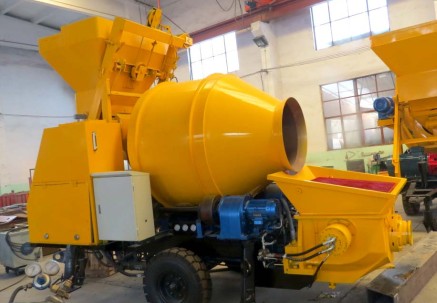Concrete Mixer Pump And Good Concrete – All You Need For A Beautiful, Durable Surface
Most contractors choose concrete when building sidewalks, driveways, steps, patios, basements, garages, and industrial floors. Concrete is inexpensive to use and results in a durable, attractive surface. Concrete is also very easy to maintain and can be stained and/or stamped to create interesting designs and colors. A good concrete mixer and pump is required to get just the right texture and consistency in the concrete and it takes some expertise to ensure the form is correctly built. It is also important to properly prepare the site. There are several steps you can take to help ensure you concrete project is hassle-free.

1. Prepare the site by removing all soft soils, vegetation, and rocks. This helps ensure the slab is uniform. If at all possible, pour the slab onto firm, undisturbed soil.
2. Build the concrete forms so the slab will slope at least two percent or a minimum of 1/4 inch per foot. This helps provide enough drainage so that water does not stand on the slab.
3. Construct a scratch template to ensure the slab thickness is uniform across the entire surface. These templates are usually made from either 2-by-6 or 2-by-4 pieces of lumber. Stakes attached to the top with a string pulled across will help ensure the slab is the same depth all the way across.
4. If your flatwork will be exposed to deicing chemicals and extreme temperature fluctuation, use air-entrained concrete. This type of concrete has between five and eight percent air content.
5. Use the right ratio of cementitious material content to aggregate size. This helps ensure the best finish and good durability once the concrete hardens. A good concrete mixer pump can help with this. Learn details here: http://concretemixerpumps.com/concrete-mixer-pump/.
6. Never use high-slump concrete and always control the addition of water from the truck. Five inches is a good slump for most hand-placed flatwork. Even if the slump is caused by admixtures, if the paste content in the upper portion of the slab is more than what it is in the lower portion, the slab can warp.
7. Be very careful to keep concrete off clothing or boots and do not let it stay on the skin for long.
8. To prevent low spots in the slab, finish off the concrete and have a bit of extra in reserve to fill in any low spots.
9. Before the concrete begins to bleed, darby or bull float the surface.
10. If there is bleed water on the surface of the slab, do not start to finish the concrete. Sweep off as much as possible and wait for it to dry. Do not use dry cement to try and soak up the water. This website will give you more detailed info: http://concretemixerpumps.com/.
11. Make the contraction joints using a groover. The groove depth should be 1/4 the depth of the slab. Doing this early can help prevent cracking.
12. If the concrete contains more than three percent entrained air, do not use a steel trowel because it can cause deterioration of the surface.
13. As soon as the concrete is poured and finished, begin curing.
A concrete slab makes a great surface for all types of uses. Getting it installed correctly results in a beautiful, durable surface. Besides concrete mixer pump, concrete pump trailer for sale is also very popular, have a look here: http://concretemixerpumps.com/concrete-trailer-pump/.
